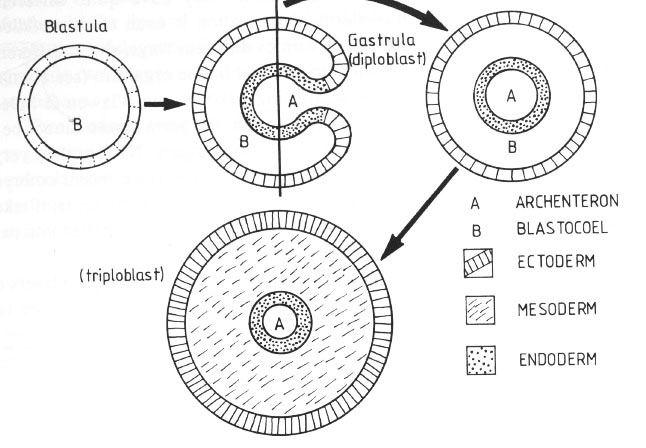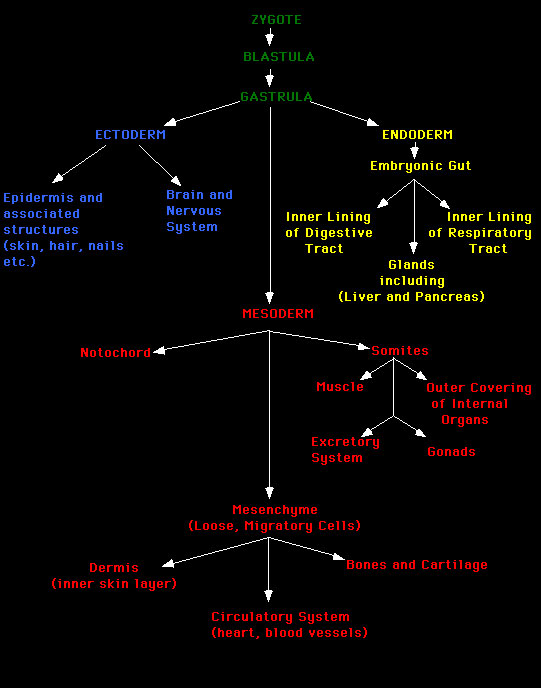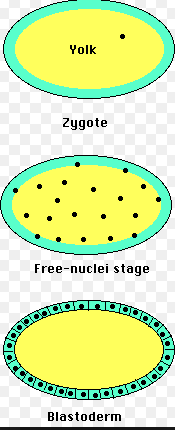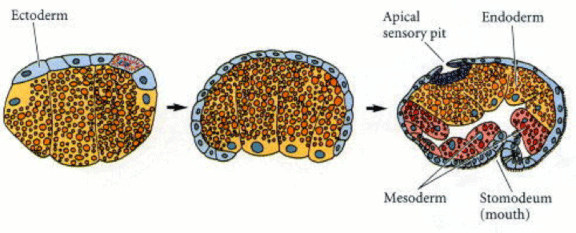On symmetry and tissue layers:
1. Body Symmetry
Animals that can be bisected or split along at least one plane, so that the resulting halves are similar to one another, are said to be symmetrical.
So animals are usually classified as:
Asymmetrical: Lacking symmetry
Radially symmetrical: The body is form of a cylinder, with one main axis around which the various body parts are arranged. In a body displaying perfect radial symmetry, the body parts are arranged equally around the axis, and any plane of sectioning that passes along the axis results in similar halves. (Like cutting a cake.)
Bilaterally symmetrical: One plane running from anterior to posterior that can dissect the animal into more or less equal halves.
Modification of these terms occurs.
One example. Pentameric: animal can be divided into five equal planes.
We will not use all the terms that cover all possible modifications.
Most differences in symmetry cannot be used to determine relationships, because for the most part, the differences in symmetry are derived from variation in habitat and lifestyle.
Asymmetry and radial symmetry is typical associated with sessile or drifting animals, bilateral symmetry is found in animals with controlled mobility.
2. Animals can be classified as having a well defined "head" or cephalization, concentration of nervous and sensory tissue and organs at the anterior end of the animal, or lacking such.
In bilateral animals one end of the body (the anterior) confronts the new environment first. So one gets a concentration of feeding and sensory structures at this end which, at one point becomes the head, when it contains the nervous tissue that innervates the sensory structures.
3. Multicellular animals are know as Metazoa. Multicellularity is correlated the development of tissues.
Tissues are a way introducing efficiency into design.
Most animals contain true tissues or aggregations of morphologically and physiologically similar cells that perform a specific function.
Some small phyla such as the Placozoa and Porifera (sponges) are believed to lack true tissues or have poorly developed tissues.
Eumetazoa are true tissue grade groups. Most phyla (higher clades) are considered Eumetazoa.
4. Animals are classified as diploblastic or triploblastic.
Germ layers initially form as outer and inner sheets of masses of embryonic tissue or ectoderm and endoderm. Two higher clades or phyla, Cnidaria (hydroids and jellyfish) and Ctenophora, have only these two layers. Primitively, talking about in adults, a layer giving rise to protective structures and a layer giving rise to digestive (feeding) structures.
Most other phyla have three layers and are triploblastic. Mesoderm is found between ectoderm and endoderm The process by which cells from the outside move into the inside eventually giving rise to endoderm and mesoderm is called gastrulation. Gastrulation is a major development event involving significant cell rearrangement. If such does not occur all development stops.
Mesoderm gives rise to connective tissue and muscle, essentially most structures in an animal. So mesoderm more potential for a more complex bauplan.
______________________________________________________________
But there are problems identifying these layers in all animals.
Ideas regarding mesoderm are derived from studies on vertebrates and very few invertebrates.
Blastulation and gastrulation varies tremendously among invertebrates.
Two real life examples:
In insects in general, blastulas form by nuclei moving to the periphery and there giving rise to cells
.
Drosophila: The Drosophila embryo is more cigar-shaped than spherical, and gastrulation occurs along a ventral seam. The photographs below are cross-sections through the tube of the embryo's body.
What you can see is that a plate of cells buckles inward and the cells roll inward as a sheet. The sheet then collapses into a mesenchymal mass that will contribute to the mesoderm of the embryo. You do not see an endodermic layer. The tube of the gut arises from invaginations at the anterior and posterior ends .
Crepidula: Gastrulation in a snail. The ectoderm undergoes epiboly from the animal pole and envelops the other cells of the embryo.
So, often it is difficult to determine three distinct layers.
__________________________________________________________
So if organisms have the organs associated with mesoderm, we assume they are triploblastic.




